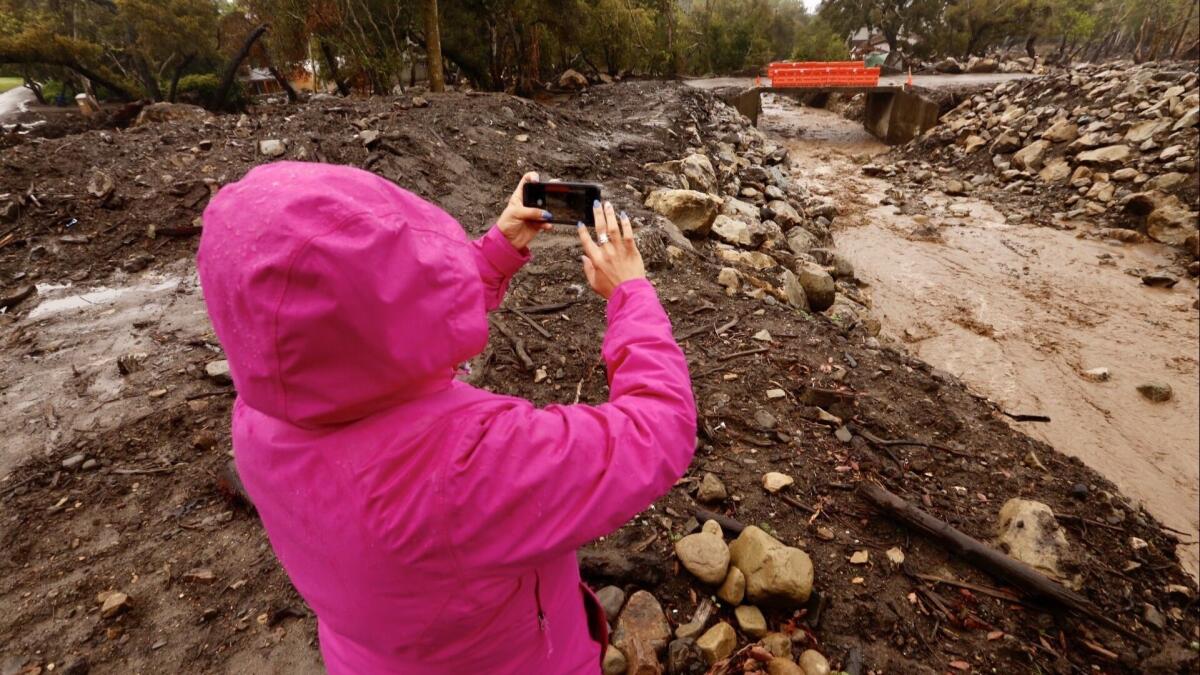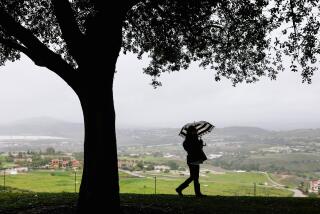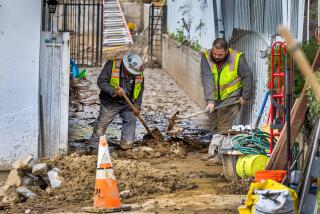Rain in the forecast for California fire areas brings concern over possible debris flow

For residents whose homes were spared by massive wildfires burning throughout the state this month, rains expected this week are prompting concern about another potentially destructive and deadly phenomenon: mudslides.
Weather experts said that rain is likely to fall midweek over areas recently affected by the Camp and Woolsey fires. The area hit by the Woolsey Fire, which spread west of the San Fernando Valley and burned to the coast, is expected to see between half an inch to an inch of rain late Wednesday into early Thursday. Showers could linger into Thursday morning, said David Sweet, a meteorologist with the National Weather Service in Oxnard.
The Woolsey blaze ravaged nearly 97,000 acres and destroyed 1,500 structures in Los Angeles and Ventura counties. Three people died and three firefighters were injured.
Heavier precipitation is anticipated in Northern California, in the area of the Camp fire. A series of storms beginning early Wednesday and lasting through Saturday is expected to bring 3 to 5 inches of rain. That fire charred 151,000 acres and destroyed more than 12,000 homes. The death toll of 79 is expected to rise as workers comb through the ruins.
While they wait for a possible second blow, families who fled the fires continued to cope with separation, loss and uncertainty.
Calvin Daley, 66, sat listening to jazz on his battery-powered radio on the front porch of his two-story home in the charred hills east of Chico. Tiny birds hopped from the burned branches of a pine tree to a bird feeder.
Nearby, Pacific Gas & Electric crews repaired voltage lines, and other workers used an excavator to move aside hunks of melted metal that once were cars.
Daley didn’t evacuate. Instead, he hooked up three hoses, stationed them around his home and began dousing everything. Some people who stayed to fight for their homes died. He had at least three hours to work before the fire arrived with fury.
He had no goggles, no mask, just jeans, a T-shirt and hoses. Sometimes, the water evaporated before hitting its target.
His next-door neighbor’s home went up: “My heart sank, I couldn’t go over there and save it.”
Flames also claimed his wife’s ski boat and his 1987 Dodge Ram. Also incinerated was the nearby Honey Run covered bridge. By 10:30 p.m. the fire had moved on. Exhausted, Daley woke himself every hour or so to check on hotspots.
It was eerily quiet for three days, then the birds returned.
Next door, the neighbor’s cats had survived. He began feeding them.
As heavy rain approaches, he’s worried contaminants will run into his well. He also worries for people who have lost homes, for people living in tents. He wishes it were summer.
At the Butte County Fairgrounds in Gridley, the five Thompsons live at the end of a row of green cots.
Hot meals are served, snacks and water are readily available, as are toiletries and American Red Cross volunteers.
“We’re having to turn stuff away,” said Melissa Thompson, 38. “Someone handed me a $100 bill, and she lost her own home. It’s victims helping victims, and it’s amazing.”
But she’d like to find out if her apartment in Magalia survived.
“The unknown is the worst part,” said Thompson who is legally blind and on disability.
As in other places, the fire caught them unawares and they ran for their lives, hopping onto two firetrucks. Daughter Savanna, 12, raced home from school to search for her family, but could not get through. She ended up in Chico before the family was reunited.
Now Savanna waits on her cot under fluorescent lights texting friends, watching YouTube videos, reading and listening to bands such as Falling in Reverse. Her favorite donated shoes are a pair of black Vans high tops and some white Adidas sneakers.
“They’re expensive, and I got them for free,” she said.
She’s not big on the 15-minute shower rule here: “It takes me 15 minutes just to get into the shower.”
Paradise Mayor Jody Jones said Sunday that authorities have estimated that it will take at least two years for her obliterated city to begin to return to life — one year to clear debris and another to rebuild.
But the period of destruction is not necessarily over.
The soil in recently burned areas cannot absorb rainwater. Enough rain can lead to fast-moving flows of up to several feet deep containing mud, debris and even trees and boulders that can be deadly for those in their path. The devastation often comes without warning.

To the south, authorities during a town hall meeting with Malibu residents last week pointed to the deadly debris flow that hit Montecito after the Thomas fire last year.
“I don’t want you to think we can stop floods if it rains. Floods will occur,” Cal Fire Chief Thom Porter said at the meeting. “Much like Montecito, the orders will be ‘evacuate,’ and you need to evacuate if you get that.”
The California Department of Forestry and Fire Protection’s watershed emergency response team has been surveying the region to determine what areas of Malibu are most at risk for mud flows in the event of a strong storm. Specific areas have not yet been publicly identified.
Twitter: @Hannahnfry
UPDATES:
6:55 p.m.: This article was updated with additional information from Paradise.
This article was originally published at 9 a.m.
More to Read
Start your day right
Sign up for Essential California for news, features and recommendations from the L.A. Times and beyond in your inbox six days a week.
You may occasionally receive promotional content from the Los Angeles Times.








